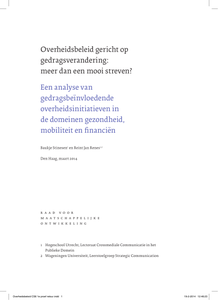Autonomous learning behavior is an important skill for students, but they often do not master it sufficiently. We investigated the potential of nudging as a teaching strategy in tertiary education to support three important autonomous learning behaviors: planning, preparing for class, and asking questions. Nudging is a strategy originating from behavioral economics used to influence behavior by changing the environment, and consists of altering the choice environment to steer human behavior. In this study, three nudges were designed by researchers in co-creation with teachers. A video booth to support planning behavior (n = 95), a checklist to support class preparation (n = 148), and a goal-setting nudge to encourage students to ask questions during class (n = 162) were tested in three field experiments in teachers’ classrooms with students in tertiary education in the Netherlands. A mixed-effects model approach revealed a positive effect of the goal-setting nudge on students’ grades and a marginal positive effect on the number of questions asked by students. Additionally, evidence for increased self-reported planning behavior was found in the video booth group—but no increase in deadlines met. No significant effects were found for the checklist. We conclude that, for some autonomous learning behaviors, primarily asking questions, nudging has potential as an easy, effective teaching strategy.
MULTIFILE
Het concept “nudging” is populair geworden door het boek van Thaler & Sunstein uit 2008 waarin nudging wordt omschreven als een manier om mensen door middel van een klein duwtje (een nudge) “betere” beslissingen te laten nemen. Hierbij gaat met ervan uit dat consumenten beïnvloed worden door irrationele motivaties. Mensen maken niet altijd keuzen die het beste zijn voor zichzelf en voor de maatschappij, met name als het gaat om routinematig gedrag, of juist om complexe keuzes. Nudges zijn simpele, niet dwingende interventies die mensen stimuleren een bepaalde keuze te maken terwijl ze hun keuzevrijheid behouden. Nudges maken het gewenste gedrag heel gemakkelijk, aantrekkelijk en sociaal. In dit rapport, uitgevoerd in het kader van het SIA praktijkonderzoek Next Fashion Retail, wordt op basis van literatuuronderzoek en interviews met vijf nudging experts een overzicht gegeven van de meest veelbelovende nudges om het kopen van duurzame mode te stimuleren.
DOCUMENT

At Fieldlab, the main goal of Logistics Community Brabant (LCB) and Breda University (BUAS) is to minimize points of contact between customers during large events, in a very, very delicate way (i.e., nudging). Crowd management has gained much attention during the COVID-19 pandemic.I was asked to conduct a literature review of human decision-making models. This information was used to develop interventions and experiments in the lab and in the field, nudging participants to behave in a more healthy and safe manner, e.g., how to safely and efficiently order beverages or exit a venue with the use of subtle environmental cues
DOCUMENT
De komende maanden wordt in Amsterdam Zuidoost een studie verricht om vast te stellen in hoeverre nudging een gezondere levensstijl kan bevorderen. Er wordt onderzocht of opgeplakte afbeeldingen van voetstapjes leiden tot toename van het gebruik van trappen.
DOCUMENT
Ter voorbereiding van zijn advies [Nr 55; 2014] over beïnvloeding van gedrag door de overheid heeft de Raad voor Maatschappelijke Ontwikkeling (RMO) aan Baukje Stinesen en Reint Jan Renes gevraagd een verkennend onderzoek te doen naar overheidsinitiatieven die zich richten op gedragsbeïnvloeding van de burger in de domeinen gezondheid, mobiliteit en financiën.
DOCUMENT

Breda University's Bert Smit & Joseph Roevens dialogue about Sustainable Experience Design, and nudging students "one mug at a time" Gaia Zoo, Apenheul Communication about Animal Conversation https://bit.ly/2IlHdeV Make Sustainable Behavior FUN https://bit.ly/2Kw2wgx Ecover NV consistent message vs Greenwashing https://bit.ly/2IlX3Gj Collaboration vs The Selfish Gene https://bit.ly/2MnTogb Balance in Green Life style - Gaia Gift https://bit.ly/2WmyMd6 Hospitality as Symbiosis: Toothpick birds & Crocodiles https://bit.ly/3127Cqq Sustainable Hospitality? Botanique Hotel & Spa https://bit.ly/2QMmnsX “Locked-in” or Re-Thinking the System: https://bit.ly/2HW55Xn AirBnB https://bit.ly/2KsqpFK Tesla, … Hamburgers vs Local Food on FIJI Island https://bit.ly/2HXPtmo Nudging students & staff at University https://bit.ly/2QLn2Lb How Bert is greening students one Nudge mug at a time https://bit.ly/2WpDxlU
LINK